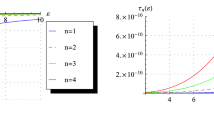Abstract
We study the absorption coefficient of a diluted magnetic semiconductor ellipsoidal quantum dot with Rashba spin–orbit coupling. The Schrödinger equation for a one-electron ellipsoidal quantum dot was solved within the framework of the effective mass approximation method. The wave vector and electron energy found during the solution were used to find an expression for the absorption coefficient. The article examines intraband optical transitions relative to changes in external parameters. The decrease in the absorption coefficient as a function of the energy of the incident photon was studied at different values of the magnetic field, the Rashba parameter, temperature, concentration of Mn atoms and the radius of the ellipsoid. According to the results obtained, these parameters significantly affect intraband optical transitions.





Similar content being viewed by others
Data availability
No datasets were generated or analysed during the current study.
References
Dresselhaus, G.: Spin–orbit Coupling Effects in Zinc Blende Structures. Phys. Rev. 100(2), 580–586 (1955). https://doi.org/10.1103/PhysRev.100.580
Rashba, E.: Properties of semiconductors with an extremum loop. I. Cyclotron and c ombinational resonance in a magnetic field perpendicular to the plane of the loop. Sov. Phys. Solid State 2, 1109 (1960)
Bychkov, Y.A., Rashba, É.I.: Properties of a 2D electron gas with lifted spectral degeneracy. JETP let. 39(2), 78 (1984)
Nitta, J., Akazaki, T., Takayanagi, H., Enoki, T.: Gate control of spin–orbit interaction in an inverted In 0.53 Ga 0.47 As/In 0.52 Al 0.48 As Heterostructure. Phys. Rev. Lett. 78(7), 1335–1338 (1997). https://doi.org/10.1103/PhysRevLett.78.1335
Nakamura, H., Koga, T., Kimura, T.: Experimental evidence of cubic Rashba effect in an inversion-symmetric oxide. Phys. Rev. Lett. 108(20), 206601 (2012). https://doi.org/10.1103/PhysRevLett.108.206601
Ast, C.R., et al.: Giant spin splitting through surface alloying. Phys. Rev. Lett. 98(18), 186807 (2007). https://doi.org/10.1103/PhysRevLett.98.186807
Ishizaka, K., et al.: Giant Rashba-type spin splitting in bulk BiTeI. Nat. Mater 10(7), 521–526 (2011). https://doi.org/10.1038/nmat3051
Moser, J., Matos-Abiague, A., Schuh, D., Wegscheider, W., Fabian, J., Weiss, D.: Tunneling anisotropic magnetoresistance and Spin–orbit Coupling in Fe/GaAs/Au tunnel junctions. Phys. Rev. Lett. 99(5), 056601 (2007). https://doi.org/10.1103/PhysRevLett.99.056601
Manchon, A., Koo, H.C., Nitta, J., Frolov, S.M., Duine, R.A.: New perspectives for Rashba spin–orbit coupling. Nat. Mater 14(9), 871–882 (2015). https://doi.org/10.1038/nmat4360
Datta, S., Das, B.: Electronic analog of the electro-optic modulator. Appl. Phys. Lett. 56(7), 665–667 (1990). https://doi.org/10.1063/1.102730
Furdyna, J.K.: Diluted magnetic semiconductors. J. Appl. Phys. 64(4), R29–R64 (1988). https://doi.org/10.1063/1.341700
Bimberg, D., Grundmann, M., Ledentsov, N.N.: Quantum dot heterostructures. Wiley, Chichester (1999)
Cho, A.: Recent developments in molecular beam epitaxy (MBE). J. Vac. Sci. Technol. 16(2), 275–284 (1979)
Barnham, K., Vvedensky, D.: Low-dimensional semiconductor structures: fundamentals and device applications, 1st edn. Cambridge University Press, Cambridge (2001)
Vorobyev, L.E., Ivchenko, E.I., Firsov, D.A., Shalygin, V.A.: Optical Property of Nanostructures. Nauka, Saint Petersburg (2001)
Liu, C.-H., Xu, B.-R.: Theoretical study of the optical absorption and refraction index change in a cylindrical quantum dot. Phys. Lett. A 372(6), 888–892 (2008). https://doi.org/10.1016/j.physleta.2007.08.046
Fakkahi, A., et al.: Optical absorption coefficients of a single electron in a multilayer spherical quantum dot with a Kratzer-like confinement potential. Res. Opt. 13, 100553 (2023). https://doi.org/10.1016/j.rio.2023.100553
Jaouane, M., Sali, A., Ezzarfi, A., Fakkahi, A., Arraoui, R.: Study of hydrostatic pressure, electric and magnetic fields effects on the donor binding energy in multilayer cylindrical quantum dots. Physica E 127, 114543 (2021). https://doi.org/10.1016/j.physe.2020.114543
Grundmann, M., Stier, O., Bimberg, D.: InAs/GaAs pyramidal quantum dots: Strain distribution, optical phonons, and electronic structure. Phys. Rev. B 52(16), 11969–11981 (1995). https://doi.org/10.1103/PhysRevB.52.11969
Cantele, G., Piacente, G., Ninno, D., Iadonisi, G.: Optical anisotropy of ellipsoidal quantum dots. Phys. Rev. B (2002). https://doi.org/10.1103/physrevb.66.113308
Zhu, J.-L.: Spectrum of donor states in an ellipsoidal quantum dot. Phys. Lett. A 269(5–6), 343–347 (2000). https://doi.org/10.1016/s0375-9601(00)00286-3
León-González, J.C., Toscano-Negrette, R.G., Vinasco, J.A., Morales, A.L., Mora-Ramos, M.E., Duque, C.A.: Influence of a non-resonant intense laser and structural defect on the electronic and optical properties of a gaas quantum ring under inversely quadratic potential. Condens. Matter 8(2), 52 (2023). https://doi.org/10.3390/condmat8020052
Galitskiy, V.M., Karnakov, B.M., Kogan, V.I.: Problems in quantum mechanics, 2nd edn. Nauka, Moscow (1992)
Babanlı, A., Balcı, M., Sabyrov, V.: Optical properties of an ellipsoidal quantum dot with a diluted magnetic semiconductor structure. J. Magn. Magn. Mater. 586, 171146 (2023). https://doi.org/10.1016/j.jmmm.2023.171146
Babanlı, A.M., Uçar, O.: Magnetoresistance of electrons in quantum ring with Rashba spin–orbit interaction. Low Temp. Phys. 47(10), 849–853 (2021). https://doi.org/10.1063/10.0006065
Gumber, S., Bhattacherjee, A.B., Jha, P.K.: Spin transport in a Rashba-coupled two-dimensional quantum ring: an analytical model. Phys. Rev. B 98(20), 205408 (2018). https://doi.org/10.1103/PhysRevB.98.205408
Anselm, A.I.: Introduction to semiconductor theory. Prenctice-Hall, Moscow (1981)
Gradshteĭn, I.S., Zwillinger, D.: Table of integrals, series, and products, 8th edn. Elsevier, Academic Press is an imprint of Elsevier, Amsterdam (2015)
Harper, R.L., et al.: Excited confined quantum states in CdMnTe-CdTe superlattices. J. Appl. Phys. 65(2), 624–628 (1989). https://doi.org/10.1063/1.343094
Sirenko, A.A., et al.: Electron and hole g factors measured by spin-flip Raman scattering in CdTe/Cd1–x Mgx Te single quantum wells. Phys. Rev. B 56(4), 2114–2119 (1997). https://doi.org/10.1103/PhysRevB.56.2114
Ilchuk, H., Zmiiovska, E., Petrus, R., Semkiv, I., Lopatynskyi I., Kashuba, A.: Optical properties of CdMnTe film: experimental and theoretical aspect s (2020)
Funding
The authors have not disclosed any funding.
Author information
Authors and Affiliations
Contributions
A.B., M.B., M.O., G.O and V.S. wrote the main manuscript text. V.S. prepared all figures. All authors reviewed the manuscript.
Corresponding author
Ethics declarations
Competing interests
The authors declare no competing interests.
Additional information
Publisher's Note
Springer Nature remains neutral with regard to jurisdictional claims in published maps and institutional affiliations.
Rights and permissions
Springer Nature or its licensor (e.g. a society or other partner) holds exclusive rights to this article under a publishing agreement with the author(s) or other rightsholder(s); author self-archiving of the accepted manuscript version of this article is solely governed by the terms of such publishing agreement and applicable law.
About this article
Cite this article
Babanlı, A.M., Balcı, M., Ovezov, M. et al. Absorption coefficient of a DMS ellipsoid quantum dot with Rashba spin–orbit interaction. J Comput Electron (2024). https://doi.org/10.1007/s10825-024-02174-5
Received:
Accepted:
Published:
DOI: https://doi.org/10.1007/s10825-024-02174-5




